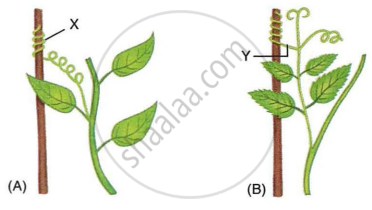Advertisements
Advertisements
प्रश्न
The plant hormone which triggers the fall of mature leaves and fruits from the plant body is:
पर्याय
auxin
gibberellin
abscisic acid
cytokinin
उत्तर
abscisic acid
Explanation:
Abscisic acid causes abscission, i.e., the falling of leaves and fruits from the plant body.
APPEARS IN
संबंधित प्रश्न
How do auxins promote the growth of a tendril around a support?
Define chemotropism.
What is meant by 'tropisms' (or tropic movements)? Explain with an example.
A potted plant is growing in a transparent glass jar. In this plant, X and Y are the two growing parts having a lot of meristematic tissue. It is observed that the part X of this plant exhibits positive geotropism but negative phototropism. On the other hand, part Y of this plant exhibits negative geotropism but positive phototropism.
(a) Name the part X of plant.
(b) Name the part Y of plant.
(c) Which part of the plant, X or Y, will exhibit positive hydrotropism?
(d) Which part of the plant, X or Y, can have tendrils on it?
(e) Which phytohormone causes the part X to exhibit negative phototropism?
While conducting experiments to study the effect of various stimuli on the plants, it was observed that the roots of a plant X grow and bend towards two stimuli A and B but bend away from a third stimulus C. The stem of the plant X, however, bends away from stimuli A and B but bends towards the stimulus C. The stimulus B is known to act on the roots due to too much weight of the earth. Keeping these points in mind, answer the following question:
- What could stimulus A be?
- Name the stimulus B.
- What could stimulus C be?
- The branches of a fallen tree in a forest grow straight up in response to two stimuli. What could be these two stimuli out of A, B and C? Also name these two stimuli.
The tropic movement that helps the climbing vines to find a suitable support is ______.
The response of a plant part towards gravity is ______.
What is chlorophyll?
Which flowering plant shows a photo nasty just opposite to that of a Dandelion?
Study the diagrams given below and answer the following questions:

- Name the structures shown as X and Y in the figures (A) and (B), respectively.
- Write the functions performed by the structures X and Y.
- Name the phenomenon depicted and define it.
- How do the structures X and Y differ from each other?
- Give examples of the plants which show the said phenomenon.
